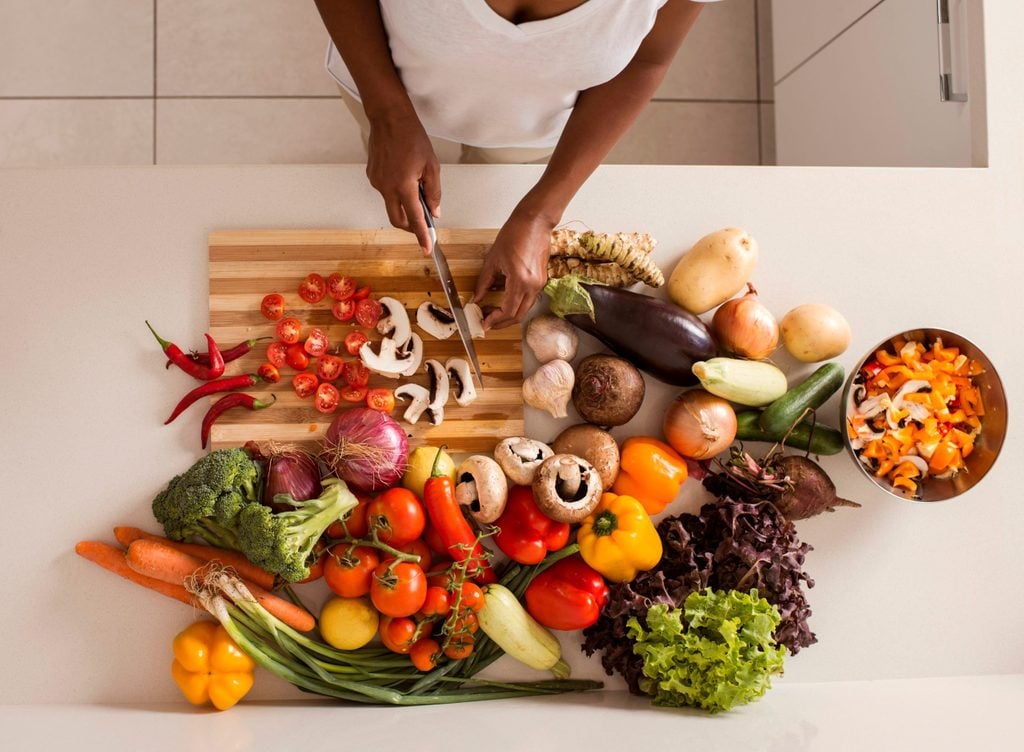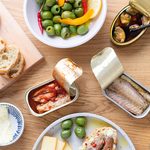5 Meal Prep Tips for People Who Want to Lose Weight

Registered dietitian Cynthia Sass shares five meal prep tips that support healthy and sustainable weight management. Check out her four-step meal-building strategy and satisfying recipe ideas.
One of the best ways to boost your nutrient intake and lose weight in a healthy and sustainable way is to cook at home more often. As a registered dietitian in private practice, I have seen home cooking transform the health of many clients. And research supports its impact on weight management.
In a study, published in 2017 in the International Journal of Behavioral Nutrition and Physical Activity, adults who consumed home-cooked meals more than five times per week were 28 percent less likely to be overweight. That’s compared to those who cooked at home fewer than three times per week. Home cooks were also 24 percent less likely to have excess body fat.
Of course, what you cook at home is just as important as how often. The key is to follow Canada’s Dietary Guidelines and focus on choosing healthy foods and beverages that are rich in nutrients, meaning whole or minimally processed foods, including plenty of plants.
(Related: How to Manage a Healthy Weight Through Lockdown)
Use a four-step meal-building strategy
To best optimize nutrient intake and support long-term weight management, the composition of home-cooked meals should also be consistent. To accomplish this, I teach my clients a simple four-step meal-building strategy.
Step 1: Start with the 50 percent rule. Cover half of your plate with raw or cooked non-starchy vegetables, or use them to comprise half of the bulk of a mixed meal. Aim for about two cups, or two tennis ball-sized portions. (Related: The Healthiest Vegetables You Can Eat)
Step 2: Add a lean source of protein. It should cover 25 percent of your plate or make up about a quarter of your meal. That’s about a deck of cards in thickness and width for meat, fish, or a veggie burger, or about a tennis ball-sized portion of beans or lentils. (Related: The Best Sources of Protein, According to the New Canada’s Food Guide)
Step 3: Fill the remaining 25 percent of your plate or meal configuration with healthful carbs. That’s about one-half to one tennis ball. Match the carb portion to your body’s corresponding energy demands. For example, opt for the smaller portion if you are less active, petite, or over 40. Include the larger portion if you are more active, taller, and/or more muscular, and younger. (Related: Silent Signs Your Body Needs You To Eat More Carbs)
Step 4: Include a source of good fat. That may be combined with one of these foods groups, such as veggies sautéed or oven roasted with a tablespoon of extra virgin olive oil, or as an add-on or garnish. The latter may include a quarter cup of nuts sprinkled on top, or a few tablespoons of pesto drizzled over the meal. (Related: How Olive Oil Benefits Your Health)
Focus on portions to curb calories
This combination of foods and targeted portions are ideal for both health and weight management. In addition to being full of nutrients, each meal is rich in filling fibre, and provides a healthy macronutrient content. This includes metabolism-revving protein, satiating fat, and just enough carbs to support your energy needs without resulting in a surplus that inhibits weight loss. Also, be sure to include all-natural seasonings to provide flavour, aroma, colour, and bonus nutrients to your meals.
These food ratios and portions also inherently cap calories. For example, non-starchy vegetables typically provide 25 calories per cup on average, compared to more than 100 calories in the same sized portion of a starchy food. Simply filling half of your plate with water-rich veggies and just a quarter with higher-carb foods, rather than the reverse (like many restaurant and takeout meals), automatically limits your calorie and carb intake. Rounding out each meal with the right balance of lean protein and good-for-you fat optimizes nutrient intake without overdoing calories.
How to prep meals
As for meal prep, there are two options. The first involves pre-preparing meal components, which can be combined as you build your plate. The second entails making complete meals in advance that are ready-to-eat (like chilled salads), or dishes that can be reheated (such as soups).
For mix-and-match meals, consider these simple, nutrient-rich options.
Non-starchy veggies
These should be 50 percent of your plate. They can be raw, sautéed, or oven-roasted.
Raw:
- Leafy greens or garden salad
- Cabbage slaw
Sautéed:
- Bell peppers and onions
- Broccoli
- Fennel
- Green beans
- Kale
- Mushrooms
- Spinach
- Zucchini
Oven-roasted:
- Brussels sprouts
- Cauliflower
- Eggplant
- Tomatoes
Lean protein
Lean protein should be 25 percent of your plate. It can be plant- or animal-based.
Plant-based:
- Beans
- Black-eyed peas
- Chickpeas
- Lentils
- Tofu
- Veggie burger patty
Animal-based:
- Chicken breast
- Ground turkey
- Hard-boiled eggs
- Tuna
- Wild salmon
Healthful carbs
Healthy carbs should make up 25 percent of your plate.
Starchy veggies:
- Beets
- Potatoes
- Sweet potatoes
- Winter squash
Whole grains:
- Corn
- Brown rice
- Quinoa
- Wild rice
Fresh fruit:
- Apple
- Berries
- Citrus
- Grapes
- Mango
- Pear
- Pineapple
Good fat
Combine good fat with veggies, protein, or carbs, or include as a garnish or add-on.
- Avocado or guacamole
- Extra virgin olive oil or avocado oil to sauté or oven roast veggies
- Extra virgin olive oil or avocado oil-based vinaigrettes and dressings
- Nuts and seeds
- Nut/seed butter sauces, like tahini and cashew “cheese” sauce
- Olive tapenade
- Pesto made with extra virgin olive oil and nuts
(Related: Meal Prep Hacks That Can Reap Some Serious Nutrition Benefits)
Try these mix-and-match meal prep ideas
To simplify meal planning, prep foods for about three days’ worth of meals at once. Choose four to five foods within each food group that can be combined in various ways. Purchase these foods, pre-prep or cook them, and stash in the fridge. That way, they’re ready to assemble at mealtime.
Meal prepping can also include stocking up on healthy shortcut items, like jarred pesto or olive tapenade and store-bought dressing made with avocado oil.
Here are some of my favourite mix-and-match meal ideas:
- Toss two cups of leafy greens with extra virgin olive oil balsamic vinaigrette. Top with a scoop of cooked lentils and a half cup of oven-roasted sweet potato.
- Cover half of your plate with broccoli, peppers, and onions sautéed in extra virgin olive oil. Fill a quarter of the plate with chicken breast or black beans and the remaining quarter with roasted corn.
- Fill a bowl with leafy greens and other non-starchy veggies, such as diced cucumber, tomato, and red onion. Add a half cup of cooked quinoa. Top with wild salmon or roasted chickpeas. Drizzle with pesto.
- Cover half of your plate with green beans sautéed in extra virgin olive oil. Fill a quarter of the plate with a cooked veggie burger patty and the other quarter with oven-roasted fingerling potatoes.
- Fill a bowl with leafy greens. Add a half cup of cooked wild rice. Top with cooked, seasoned ground turkey or white beans. Drizzle with tahini dressing.
- Toss two cups of leafy greens with oil-free citrus vinaigrette. Top with a scoop of cubed tofu, a sliced apple, and a quarter cup of nuts.
- Cover half of your plate with oven-roasted Brussels sprouts. Fill a quarter of the plate with a cooked veggie burger patty and the other quarter with oven-roasted butternut squash. Garnish your plate with sprouted pumpkin seeds.
(Related: Healthy Foods That Are Actually Dangerous to Overeat)
Prepare balanced make-ahead mixed dishes
When prepping mixed meals, go for dishes that hold up well to refrigeration or reheating. And aim for the same portions and balance within each meal as above. Healthful, balanced options include:
- Chilled veggie pasta salad made with two cups of spinach and chopped veggies, a scoop of white beans, a half cup of brown rice penne, and a few tablespoons of jarred pesto
- Simple soup made with yellow onions sautéed in extra virgin olive oil to start. Add low-sodium organic veggie broth and more veggies, such as zucchini, tomatoes, and mushrooms, as well as garlic and herbs. Bring to a quick boil and then reduce to a simmer for 15-20 minutes. Add cooked ground turkey or lentils, and a half cup of cooked brown rice. Stir to heat through.
- Healthy pad Thai made with two cups of steamed or sautéed veggies combined with cubed tofu and a half cup of cooked buckwheat soba noodles tossed in savory peanut butter sauce
Adjust online recipes to create a healthier balance
Check out cookbooks or the internet for other make-ahead meal ideas. Don’t be afraid to tweak the portions or recipes to fit the simple four-step meal-building strategy. For example, add extra veggies, or serve a dish with salad or cooked veggies on the side. Reduce portions of carb-rich ingredients. And be sure to include healthful sources of protein and fat in each meal.
Finally, keep in mind that successful weight management is a marathon, not a sprint. In other words: It’s all about balance, lifestyle, and consistency—not a quick fix. The four-step tactic for how to build home-cooked meals is a major tool. Use it most days of the week to create meals that allow you to feel full, satisfied, and energized. And enjoy some planned splurges, too. Doing so can help you shed excess pounds safely and boost your overall wellness, all while you remain healthy, happy, and in it for the long haul.
Next: 9 Tricks to Make Your Diet a Little More Mediterranean




